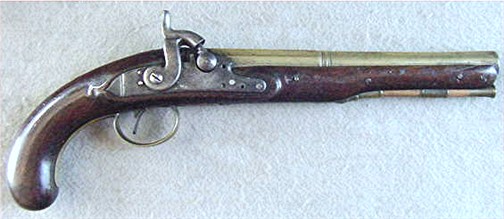|
MAKER MARKED “KEENER” OF BALTIMORE PERCUSSION
SINGLE SHOT PISTOL – BRASS OCTAGON-TO-ROUND BARREL –VERY
ATTRACTIVE EARLY 19TH CENTURY AMERICAN MADE
PISTOL: This very attractive percussion single
shot pistol has a number of features which identify it
as having been made in the early 19TH
Century. Its overall appearance is in the style of the
pistols produced for the commercial market which
included sales to military officers, private citizens,
and to the fur trade companies operating on the edges of
the North American frontier.

Originally manufactured as a flintlock, at some point
the pistol was converted to percussion as the technology
advanced. The lock plate retains the original holes for
mounting the pan, frizzen and frizzen spring – all of
which were removed during the conversion – and the
hammer was replaced with a percussion hammer. The
ignition conversion was completed by the installation of
the nipple and drum. The profile of the lock plate
exactly fits the stock mortise which indicates it was
original to this pistol.
Assuming this is the case, the lock plate’s maker mark
“KEENER” indicates this pistol was manufactured by one
of the Keeners, a large family of gunmakers in the City
of Baltimore, Maryland appearing in the records as early
as 1776 and as late as 1831. The members of the family
identified in the gun making trade include John, Jacob,
Peter, and Samuel.
The lock is fully functional, the hammer holds at both
the half and full cock positions and the trigger let off
is very crisp.
Measuring 9” long, the brass octagon-to-round barrel
features the wedding band transition between the two
profiles, in the same manner as seen on the Northwest
Serpent Side Plate Trade Guns of the fur trade. The
barrel finished with an engraved steel breech plug and
the barrel is full form with no misshaping or damage on
the outer surface. The .62 caliber bore is not rifled,
is overall smooth, and the brass retains a dark
naturally aged patina. The barrel bears the two English
proof stamps adopted in 1813 for the new Birmingham
Gunmakers Proof House, however the top of the barrel
lacks the “LONDON” stamp noted on similar pistols of
this style made by Ketland, Sharpe and others makers in
England. A large number of English made gun parts,
including barrels, continued to be imported into the
United States and used by American gunmakers, and the
absence of the “LONDON” stamp further suggests this
pistol was made in the United States.
The stock is full form with no loss along the barrel
channel, and no breaks or missing wood. There is a very
short age check emanating from the front barrel pin
towards the muzzle, but the wood is stable and it shows
no indicating of enlarging or causing a break. The
surface of the wood shows the expected handling marks,
but no significant dents or disfigurement and the
original finish is still intact over the majority of the
surface. The overall length of the pistol is 14 ¾”.
The trigger guard, ramrod thimbles and lock screw
washers are all made of brass, and there is a silver
escutcheon shield-shaped inlay on the top of the wrist.
The front finial of the trigger guard is finished in the
shape of a pineapple with nicely engraved details.
This is a very attractive, early manufacture, American
made pistol which dates to our young nation’s first
expansions onto the Western frontier. (0715) $2,000
|

